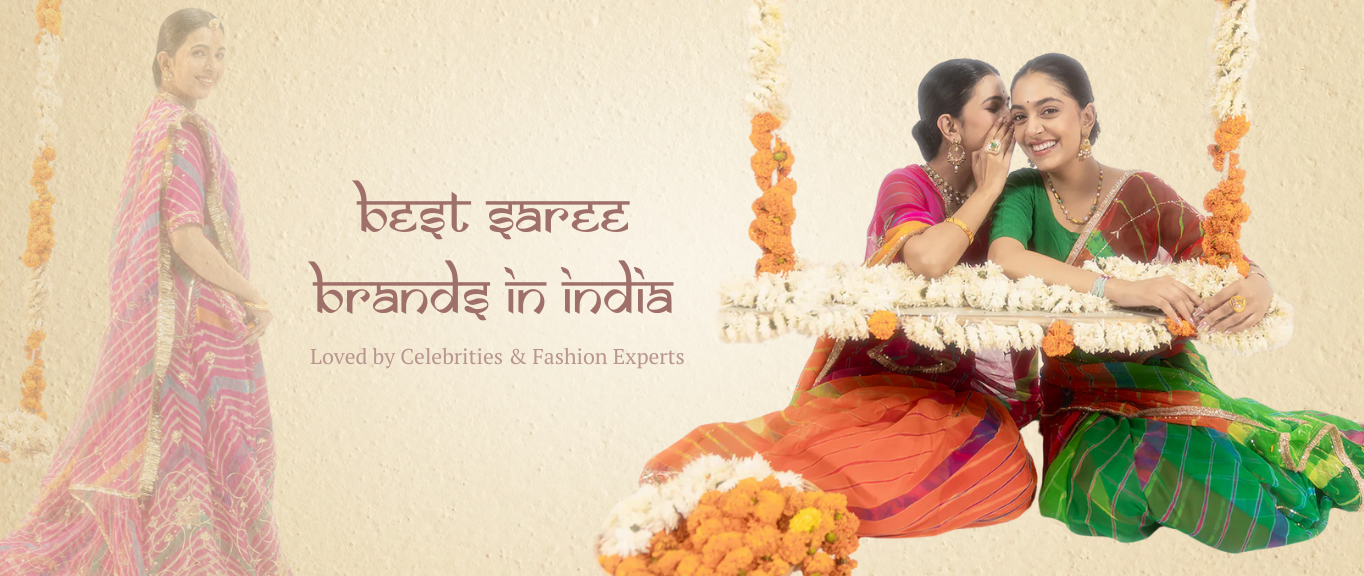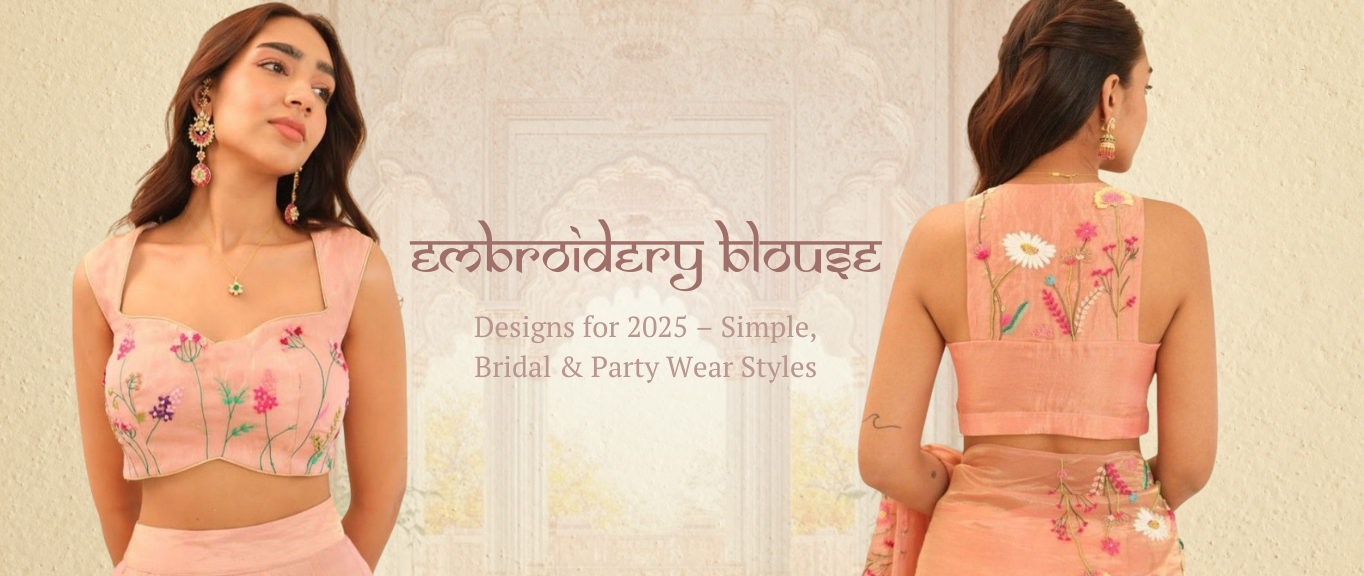30+ Unique Saree Draping Styles You Can Try for Every Occasion
The saree represents more than fabric; it embodies everlasting elegance, grace, and cultural legacy. Traditional drape styles look beautiful, yet different saree draping methods will make every occasion more stunning. The method you choose to arrange your saree will revolutionize your ensemble, no matter what social setting you have in mind.
A saree can be of any style, from the dramatic Nivi drape of Andhra Pradesh to the elegant Belted saree look, through numerous distinctive draping choices that suit personal style and event type. Contemporary women can enjoy comfort and sophistication through the Dhoti drape and the Pant-style saree adaptations. Want to add drama? Two great options are the Butterfly drape along the Lehenga-style saree. Look for the Bengali Atpoure drape or the Kerala Mundum Neriyathum to achieve a simple yet elegant appearance.
This guide reveals 30+ exceptional saree draping styles of your saree, adding uniqueness to your look in 2025. These draping methods will enrich your collection and improve the versatility and sleekness of traditional sarees. Get ready to elevate your saree drapes. Let’s dive in!
Different Saree Draping Styles for Every Occasion
Now let us look at the best saree draping styles you can try for every occasion and flaunt beautifully like never before -
1. Nivi or Basic Saree Draping
Residents of Andhra Pradesh primarily wear the Nivi style of saree draping, which has become the standard method. The draping technique includes pleating the fabric cuff at the waist while the pallu hangs from the left shoulder. Nivi draping provides a perfect combination of elegance and comfort, thus making it suitable for all situations ranging from normal days to business meetings and party events.
2. Bengali Saree Draping
A Bengali drape displays its attractive appearance through two spacious pleats with a pallu that covers the shoulder twice. Traditionally, people draped this style with puffed-sleeved blouses while wearing 'chabi guchha' (key ring), among other accessories; hence, it became popular for red-and-white saree festivals during Durga Puja.
3. Dhoti Style Saree Draping
Characterized by modern elements and cultural heritage, the dhoti-style saree combines the best contemporary and traditional aesthetics. Draping this flat clothing follows traditional male dhoti customs where pleats get folded around legs to form contemporary pants-like silhouettes. This innovative draping technique provides stylish comfort for fashionable women who lead trends in fashion.
4. Lehenga Style Saree Draping
Weddings and grand celebrations find their perfect drape in this style because it turns a saree into an elegant lehenga. Like lehengas, the saree material is folded into multiple layers to create a flow. At the same time, the blouse maintains a structured design, and the pallu drape appears similar to a dupatta.
5. Double Saree Draping
Two sarees placed one on top of another become a glamorous version of classic draping, resulting in lovely color contrasts. The wedding combination works perfectly for such formal events because it combines different textures and shades to create an elegant depth.
6. Belted Saree Draping
People use belts to define their saree appearance by draping it traditionally and then drawing it tight at their waist. People use this style in contemporary and fusion fashion because it shapes their figure and provides agility during movement. Works well for weddings and contemporary occasions.
7. Pant Style Saree Draping
This contemporary fashion innovation unites the saree with formal pants and legging alternatives to traditional petticoats. Whether draping the pallu as a shoulder covering or fashioning it into a cape shape, it creates an attractive mix of traditional and contemporary elements.
8. Dupatta Saree Draping
Through this method, people get the appearance of having a saree draped with a dupatta. The neatly folded saree portions get stacked before duplication of both pallus ends, which forms a stylish and convenient dress outfit suitable for formal events.
9. South Indian Saree Draping
Brides and classical dancers love this draping technique since its deep pleats make their movements effortless. A secure pin placement of the pallu on the body creates a noble appearance that symbolizes silk Kanjeevaram sarees.
10. Modern Chic Draping
The modern approach to traditional sarees combines unconventional pleating arrangements with unique blouse patterns and nonconformist approaches to draping them. It has become a signature silk Kanjeevaram saree look for fashion influencers and red-carpet events since it combines fashion-forward elegance with graceful elements.
11. Butterfly Saree Draping
The Bollywood-inspired drape appears with extremely narrow pleats, resulting in flowy butterfly-inspired folds. Many people select this draping style because it flatters the waistline through its sheer saree pairing to create an evening outfit that is stylish and elegant.
12. Reverse Pallu
In this style, the pallu changes direction from the rear to the front position. The style improves the visibility of intricate saree designs while paired with high-end blouses to create an elegant, sophisticated appearance.
13. Palazzo Saree Draping
Fusing a saree with palazzo pants instead of petticoats produces a contemporary twist that creates a modern fusion appearance. The pallu gets arranged in a dupatta style and provides comfort while maintaining a modern, fashionable appearance. This draping style serves best for celebrations and festive occasions.
14. Cape Style Saree Draping
The draping style adds a royal touch through its cape presentation that rests upon the saree instead of using the typical pallu. The traditional drape enriches the traditional look of the outfit, which makes it fashionable for wedding ceremonies and reception events.
15. Bhagalpuri Saree Draping
Traditional draping of the Bhagalpuri style in Bihar maintains the pallu in a long and flowing form with shoulder pinning that creates simplicity and elegance. This style complements both silk sarees and handwoven fabrics.
16. Half Saree Draping
Indian folklore shows the half-saree emerged as a draping combination of a flaring skirt with a traditional saree-inspired garment known as a dupatta. Women typically use this draping style at their pubertal ceremonies and cultural social occasions.
17. Tribal Draping
Tribal communities from India originally invented this method by using a saree as a garment instead of a petticoat, which ensured unrestricted body movement. The pallu becomes secured across the torso, or it serves as an accessory on the shoulder.
18. Rajputi Saree Draping
Rajasthani nobility defined this royal drape through its flowing pallu as a head covering through a veil. Women create a royal and elegant ensemble by wearing sarees with elaborate embroidery and wearing a high-neck blouse.
19. Rajasthan Tribal Draping
Traditional rural women in Rajasthan arrange their clothing through this specific draping pattern, creating a practical waist knot with a short veil to preserve cultural traditions.
20. Gujarati Draping
The Gujarati drape called ‘Seedha Pallu’ allows the front design to remain visible as the fabric extends straight across instead of falling behind the shoulder.
21. Marathi Saree Draping
The Nauvari saree drape draws its inspiration from the warrior women of Maharashtra and involves folding the saree like a dhoti before fashioning a nice pin-up for the pallu.
22. Voni Draping
The Voni draping technique consists of traditional South Indian drape methods for young girls who wear a combination of a skirt and blouse with a dupatta for a half-saree appearance.
23. Assamese Drape
The Mekhela Chador, also known as the Assamese drape, consists of a roomy bottom and a graceful pallu that is carefully folded over the shoulder. The Assamese people wear this garment routinely for Bihu festivities and Assamese wedding ceremonies.
24. Madisar Drape
Among Tamil Brahmins, the Madisar drape uses nine yards of cloth to create a lower section like a dhoti that gives mobility while symbolizing cultural importance during religious functions.
25. Kappulu Style Saree Draping
People in Andhra Pradesh use this obscure draping style to enhance their attire at official ceremonies because its tucked-in pleat design gives an elegant appearance.
26. Kunbi Drape
The Goan tribal women use the Kunbi saree for its simple draping method that requires wearing the fabric without pleats and securing it on the shoulder.
27. Coorgi Style Saree Drape
The Coorgi drape stands out by creating back pleats while securing the pallu to the right shoulder, thus creating an organized but elegant outcome.
28. Front Pallu Saree Draping
This saree technique bases the appearance of the Gujarati style on front pallu placement, which best highlights elaborate embroidery work or embroidery edges.
29. Seedha Pallu Saree Draping
Resident to northern India, this draping technique transports the back pallu to become the front accessory to showcase decorative embellishments elegantly.
30. Madisaru Saree Draping
Traditional for Tamil Iyengar and Iyer communities, this traditional outfit is used in religious settings because it combines comfort and suitable coverage.
31. Parsi Style Saree Draping
Gara drape refers to the stylish way of draping the saree where the pallu is positioned high on the shoulder and held in place by brooches to create a sophisticated, refined look.
32. Jacket Saree Draping
The Jacket Saree Draping incorporates traditional sarees through their combination with structured or embellished jackets. Since this styling method creates a stylish combination with additional warmth, it is best suited for formal occasions and winter weddings. A short cropped jacket creates elegant vibes, while a long embroidered jacket gives a royal appearance.
33. Gown Saree Draping
A pre-stitched or draped style keeps the saree's pleating and draping shape while adopting a dress-like form. The Gown Saree Draping provides a sophisticated appearance with fuss-free elegance suitable for cocktail events, luxurious receptions, and red-carpet ceremonies.
34. Slit Saree Draping
For a dramatic modern spin on traditional drapes, the Slit Saree Draping integrates a slit on the front or side that provides both comfort and seductive grace. Slit Saree Draping stands as a modern option suitable for parties along with high-fashion events when combined with statement heels and modern accessories.
Best Saree Draping Hacks & Tips
Wearing a perfect saree drape seems initially complex, but various simple tricks help you easily achieve an elegant, structured look. These guidelines will assist new saree wearers and anyone seeking greater comfort to master this classic outfit.
1. Choose the Right Underskirt & Fabric
Get a capable underskirt that fits well and coincides with your saree to prevent wrinkles from harming your overall look.
The choice between an underskirt material depends on the saree weight: cotton for silk and satin or lycra for chiffon or georgette.
2. Secure the Pleats Smartly
A safety pin will help secure pleats before their insertion into the garment. These measures will prevent the pleats from moving because of the day.
Those who struggle with pleating should utilize an iron to press the pleats for formal look results.
3. Double Pin for a No-Fuss Pallu
Secure your pallu against your shoulder with a pin since moving freely will risk its accidental removal.
To enhance safety, tuck your pallu under the shoulder area of your blouse, then place a pin on it from within.
4. The Use of Belts
One can choose a beautiful belt to beautify the saree and maintain its position throughout the day as the pleats stay in place.
5. The Right Footwear Makes a Difference
Testing your heels beforehand enables the right measurement of the saree length, thus preventing hasty modifications.
6. Use Hairspray
Hairspray can be applied lightly to slippery saree fabric pleats to prevent them from getting out of shape.
These easy methods enable you to wear your saree with pride and sophistication, resulting in refined drapes that appear easy and elegant.
Here Are Some Celebrity Saree Draping Styles To Get You Inspired
Learning about saree draping styles never gets boring, and Bollywood is the trendsetter. The stars have brought a modern approach to classic drapes, from red-carpet affairs to wedding festivities. Here’s the list of some of the iconic saree draping styles & how you can dress similarly for various occasions -
-
Deepika Padukone’s Saree look with a Belt
Deepika has also been known to pair statement belts with her sarees to give them structure with a modern twist. This style is ideal for cocktail parties or receptions. To recreate:
-
Choose a structured saree (something like silk or georgette).
-
Pleat it carefully and wear a belt at the waist.
-
Team with a high-neck top or a full-sleeved design for a regal appeal.
-
Priyanka Chopra and her Dhoti Saree Looks
Priyanka raises the bar with her dhoti-style saree, blending supreme comfort and high fashion. Perfect for fusion-themed parties or modern wedding functions. To achieve this look:
-
Consider fitted leggings to replace the petticoat.
-
Thereafter, drape the saree like a dhoti and pin it up.
-
Pair it with a peplum or an off-shoulder blouse for drama.
-
Sonam Kapoor’s Cape Saree Avatar
Sonam has tried experimental saree styles, including capes, which gave off a queen and edginess. This style is ideal for receptions or fashion-forward events. To recreate:
-
Select a light fabric saree such as chiffon.
-
In the Indo-Western style, a cape-style blouse or a sheer cape can be added over the saree.
-
Minimal accessories, and let the cape do the talking.
-
Pre-Stitched Ruffle Saree Worn By Shilpa Shetty
Shilpa Shetty has slayed pre-stitched, ruffle sarees with the perfect chic yet easy-to-wear vibe. For a sangeet or a high-energy event, this is a fantastic option. To replicate:
-
Choose a pre-stitched or ruffled saree.
-
Opt for a fitted corset-style blouse.
-
Wear chunky jewelry but keep it minimal to balance the look.
Taking cues from these Bollywood stars, you can drape the saree in numerous styles to suit the occasion while effortlessly combining tradition with contemporary sophistication!
How to Accessorize Various Saree Drapes?
The correct choice of accessories allows a saree drape to transform into a stylish ensemble effortlessly.
Blouse choices significantly matter because wearing traditional Nivi drapes benefits from embroidered blouses. Yet, dhoti drapes pair nicely with structured crop tops, and butterfly drapes demand deep-neck backless blouses as a touch of boldness.
The drape of your saree determines what jewelry you should wear because temple-style gold jewelry complements South Indian drape styles, tribal drapes call for chunky silver pieces, and contemporary draperies work best with sleek diamond jewelry.
Ethnic footwear works perfectly with traditional lehenga drapes, while stilettos enhance the appearance of sarees styled as pants.
Both traditional drapes and lehengas pair best with Kolhapuris and Mojaris.
Your accessories should complement the overall mood of your saree drape so you can achieve an eye-catching ensemble.
Wrapping Up
The saree changes according to diverse fashion needs and individual personality attributes. Exploring numerous draping techniques allows you to redefine traditional saree-wearing for better comfort and style.
When wearing a saree, the critical factor is wearing it confidently, no matter which type of drape you choose. When you wear a saree, you should try different draping techniques to create captivating looks.
Remember, a saree deserves more than casual wear because it should be celebrated and not just be worn!
Flaunt in Style with Yuvti’s Rajasthani Poshak
Yuvti by Bhupendra Singh brings together Rajputi Poshaks made by hand through their skilled artisans who unite Rajasthani cultural elements with a modern minimalistic style. Bhupendra Singh carefully creates each ensemble because quality and authenticity are core brand principles.
Yuvti showcases various designs and fabrics that champion every creation's authentic Rajasthani cultural legacy. Your search for the perfect outfit will lead you to their exquisite collection with tradition and style.
Frequently Asked Questions
-
What is the simplest style for novices to wear a saree?
Beginners with sarees should select the Nivi drape (traditional style) because it remains a traditional yet preferred draping method.
-
How should brides choose their wedding-appropriate draping styles for sarees?
A wedding requires the Lehenga-style, Mermaid, or Rajrani drape to create a faultless appearance.
-
Can you recommend strategies to create an up-to-date ensemble using my saree?
A modern depiction of your saree can be created through Pant-style and Dhoti drapes and Belted draping.
-
Which saree draping style will help you get a slim and tall glance?
The Seedha Pallu and Butterfly drapes create a slimmed-down and height-increasing effect.
-
Can I wear a saree without requiring a petticoat?
Yes! Traditional sarees look best when draped as Dhoti with trousers or Pant-style leggings.
-
What can be the best saree drape for office wear?
The Bengali Atpoure and Nivi drape create an official office-ready elegant professional attire combined with pleated drapes.
-
Do you have any tips to prevent the saree from rejecting your efforts to tie it?
Simple safety pins preserve pallu pleats, while a belt keeps the saree neatly positioned.
-
Which saree drape works too well for shapely women?
Both Seedha Pallu and Mermaid drapes enhance curves in a way that results in a perfect body contour.
-
Can I wear a saree for a casual look?
The Indo-Western drape and Cape-style sarees are appropriate for casual events and fusion costumes.


